2007 CHEVROLET EQUINOX child restraint
[x] Cancel search: child restraintPage 1 of 492
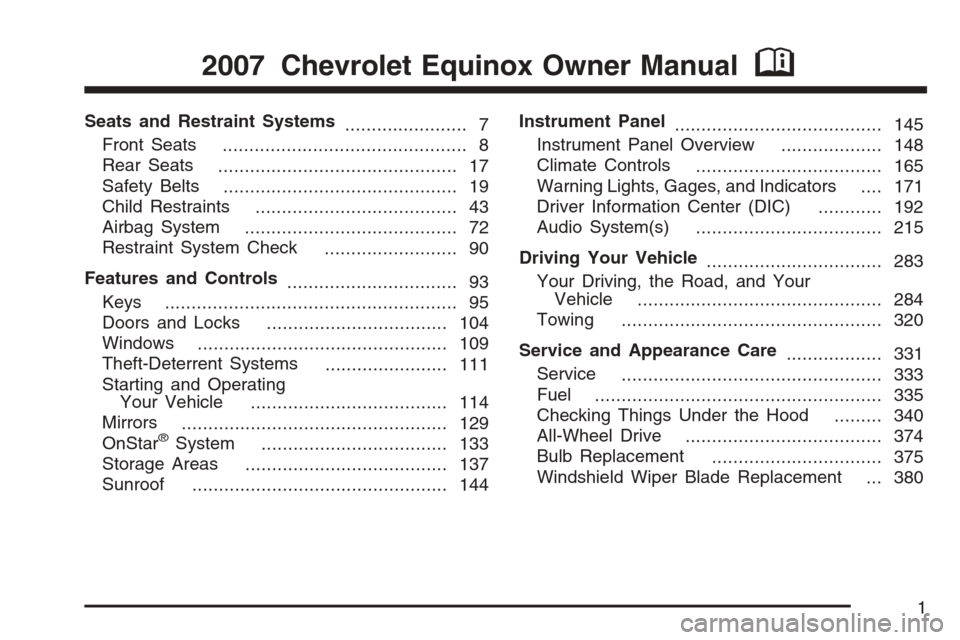
Seats and Restraint Systems
....................... 7
Front Seats
.............................................. 8
Rear Seats
............................................. 17
Safety Belts
............................................ 19
Child Restraints
...................................... 43
Airbag System
........................................ 72
Restraint System Check
......................... 90
Features and Controls
................................ 93
Keys
....................................................... 95
Doors and Locks
.................................. 104
Windows
............................................... 109
Theft-Deterrent Systems
....................... 111
Starting and Operating
Your Vehicle
..................................... 114
Mirrors
.................................................. 129
OnStar
®System
................................... 133
Storage Areas
...................................... 137
Sunroof
................................................ 144Instrument Panel
....................................... 145
Instrument Panel Overview
................... 148
Climate Controls
................................... 165
Warning Lights, Gages, and Indicators
.... 171
Driver Information Center (DIC)
............ 192
Audio System(s)
................................... 215
Driving Your Vehicle
................................. 283
Your Driving, the Road, and Your
Vehicle
.............................................. 284
Towing
................................................. 320
Service and Appearance Care
.................. 331
Service
................................................. 333
Fuel
...................................................... 335
Checking Things Under the Hood
......... 340
All-Wheel Drive
..................................... 374
Bulb Replacement
................................ 375
Windshield Wiper Blade Replacement
... 380
2007 Chevrolet Equinox Owner ManualM
1
Page 7 of 492
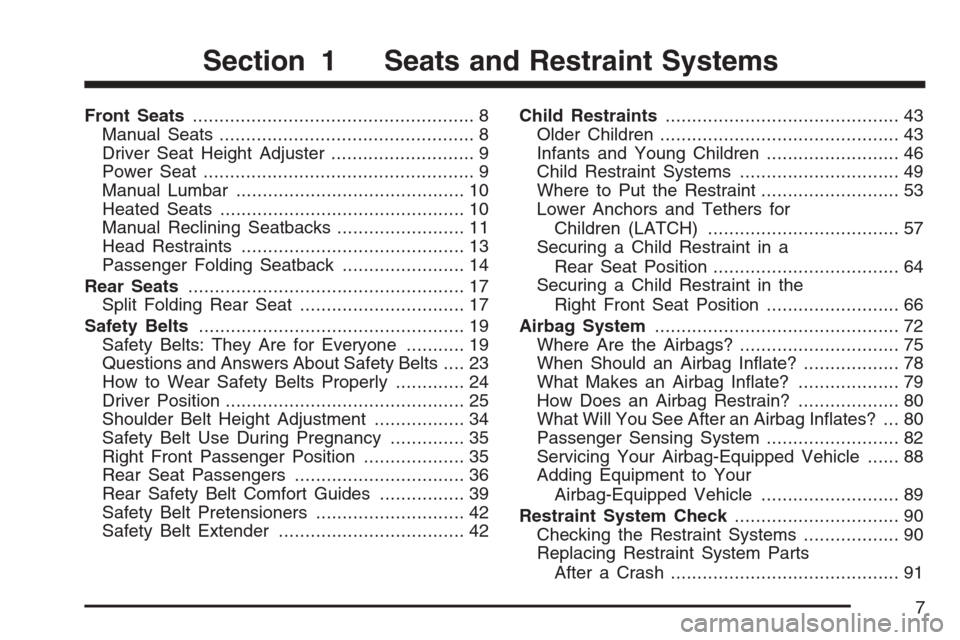
Front Seats..................................................... 8
Manual Seats................................................ 8
Driver Seat Height Adjuster........................... 9
Power Seat................................................... 9
Manual Lumbar........................................... 10
Heated Seats.............................................. 10
Manual Reclining Seatbacks........................ 11
Head Restraints.......................................... 13
Passenger Folding Seatback....................... 14
Rear Seats.................................................... 17
Split Folding Rear Seat............................... 17
Safety Belts.................................................. 19
Safety Belts: They Are for Everyone........... 19
Questions and Answers About Safety Belts.... 23
How to Wear Safety Belts Properly............. 24
Driver Position............................................. 25
Shoulder Belt Height Adjustment................. 34
Safety Belt Use During Pregnancy.............. 35
Right Front Passenger Position................... 35
Rear Seat Passengers................................ 36
Rear Safety Belt Comfort Guides................ 39
Safety Belt Pretensioners............................ 42
Safety Belt Extender................................... 42Child Restraints............................................ 43
Older Children............................................. 43
Infants and Young Children......................... 46
Child Restraint Systems.............................. 49
Where to Put the Restraint.......................... 53
Lower Anchors and Tethers for
Children (LATCH).................................... 57
Securing a Child Restraint in a
Rear Seat Position................................... 64
Securing a Child Restraint in the
Right Front Seat Position......................... 66
Airbag System.............................................. 72
Where Are the Airbags?.............................. 75
When Should an Airbag In�ate?.................. 78
What Makes an Airbag In�ate?................... 79
How Does an Airbag Restrain?................... 80
What Will You See After an Airbag In�ates? ... 80
Passenger Sensing System......................... 82
Servicing Your Airbag-Equipped Vehicle...... 88
Adding Equipment to Your
Airbag-Equipped Vehicle.......................... 89
Restraint System Check............................... 90
Checking the Restraint Systems.................. 90
Replacing Restraint System Parts
After a Crash........................................... 91
Section 1 Seats and Restraint Systems
7
Page 24 of 492
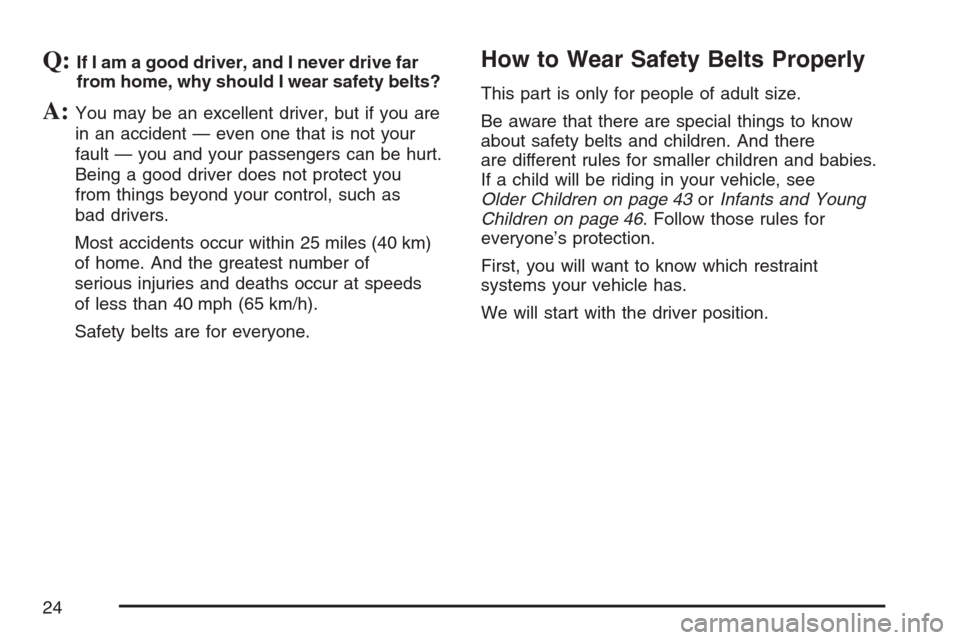
Q:If I am a good driver, and I never drive far
from home, why should I wear safety belts?
A:You may be an excellent driver, but if you are
in an accident — even one that is not your
fault — you and your passengers can be hurt.
Being a good driver does not protect you
from things beyond your control, such as
bad drivers.
Most accidents occur within 25 miles (40 km)
of home. And the greatest number of
serious injuries and deaths occur at speeds
of less than 40 mph (65 km/h).
Safety belts are for everyone.
How to Wear Safety Belts Properly
This part is only for people of adult size.
Be aware that there are special things to know
about safety belts and children. And there
are different rules for smaller children and babies.
If a child will be riding in your vehicle, see
Older Children on page 43orInfants and Young
Children on page 46. Follow those rules for
everyone’s protection.
First, you will want to know which restraint
systems your vehicle has.
We will start with the driver position.
24
Page 35 of 492
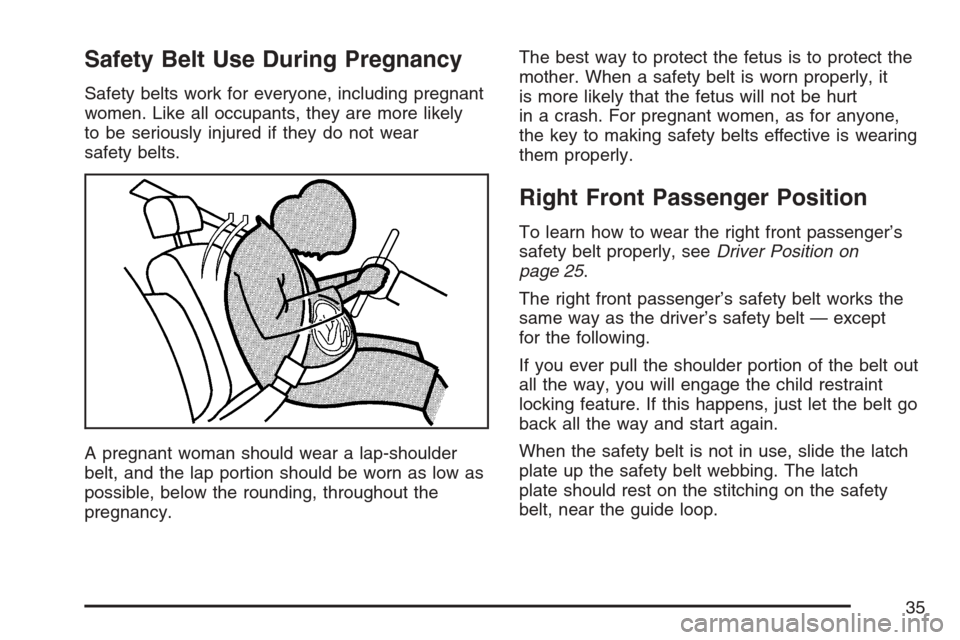
Safety Belt Use During Pregnancy
Safety belts work for everyone, including pregnant
women. Like all occupants, they are more likely
to be seriously injured if they do not wear
safety belts.
A pregnant woman should wear a lap-shoulder
belt, and the lap portion should be worn as low as
possible, below the rounding, throughout the
pregnancy.The best way to protect the fetus is to protect the
mother. When a safety belt is worn properly, it
is more likely that the fetus will not be hurt
in a crash. For pregnant women, as for anyone,
the key to making safety belts effective is wearing
them properly.
Right Front Passenger Position
To learn how to wear the right front passenger’s
safety belt properly, seeDriver Position on
page 25.
The right front passenger’s safety belt works the
same way as the driver’s safety belt — except
for the following.
If you ever pull the shoulder portion of the belt out
all the way, you will engage the child restraint
locking feature. If this happens, just let the belt go
back all the way and start again.
When the safety belt is not in use, slide the latch
plate up the safety belt webbing. The latch
plate should rest on the stitching on the safety
belt, near the guide loop.
35
Page 42 of 492
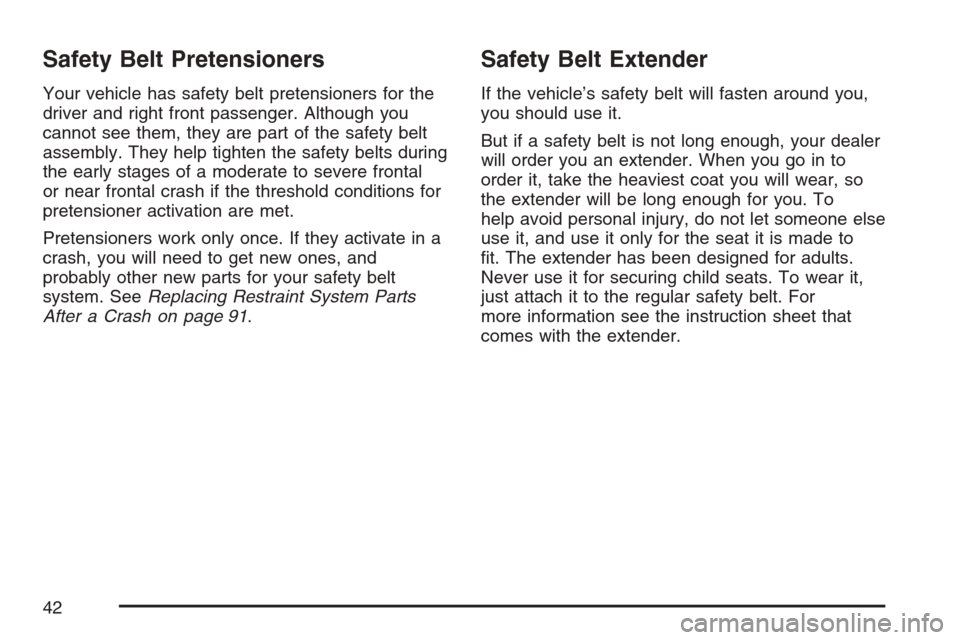
Safety Belt Pretensioners
Your vehicle has safety belt pretensioners for the
driver and right front passenger. Although you
cannot see them, they are part of the safety belt
assembly. They help tighten the safety belts during
the early stages of a moderate to severe frontal
or near frontal crash if the threshold conditions for
pretensioner activation are met.
Pretensioners work only once. If they activate in a
crash, you will need to get new ones, and
probably other new parts for your safety belt
system. SeeReplacing Restraint System Parts
After a Crash on page 91.
Safety Belt Extender
If the vehicle’s safety belt will fasten around you,
you should use it.
But if a safety belt is not long enough, your dealer
will order you an extender. When you go in to
order it, take the heaviest coat you will wear, so
the extender will be long enough for you. To
help avoid personal injury, do not let someone else
use it, and use it only for the seat it is made to
�t. The extender has been designed for adults.
Never use it for securing child seats. To wear it,
just attach it to the regular safety belt. For
more information see the instruction sheet that
comes with the extender.
42
Page 43 of 492
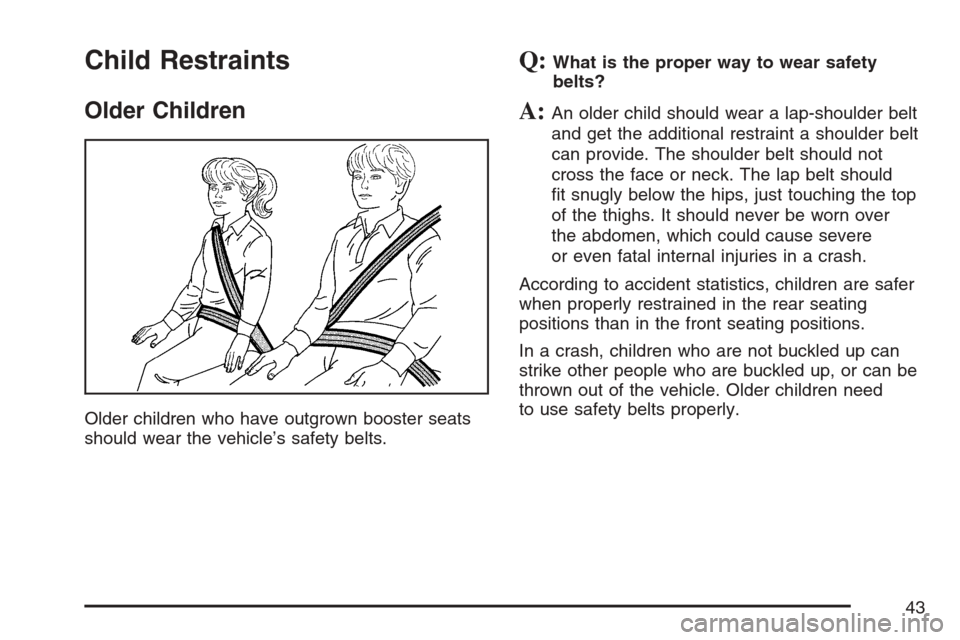
Child Restraints
Older Children
Older children who have outgrown booster seats
should wear the vehicle’s safety belts.
Q:What is the proper way to wear safety
belts?
A:An older child should wear a lap-shoulder belt
and get the additional restraint a shoulder belt
can provide. The shoulder belt should not
cross the face or neck. The lap belt should
�t snugly below the hips, just touching the top
of the thighs. It should never be worn over
the abdomen, which could cause severe
or even fatal internal injuries in a crash.
According to accident statistics, children are safer
when properly restrained in the rear seating
positions than in the front seating positions.
In a crash, children who are not buckled up can
strike other people who are buckled up, or can be
thrown out of the vehicle. Older children need
to use safety belts properly.
43
Page 44 of 492
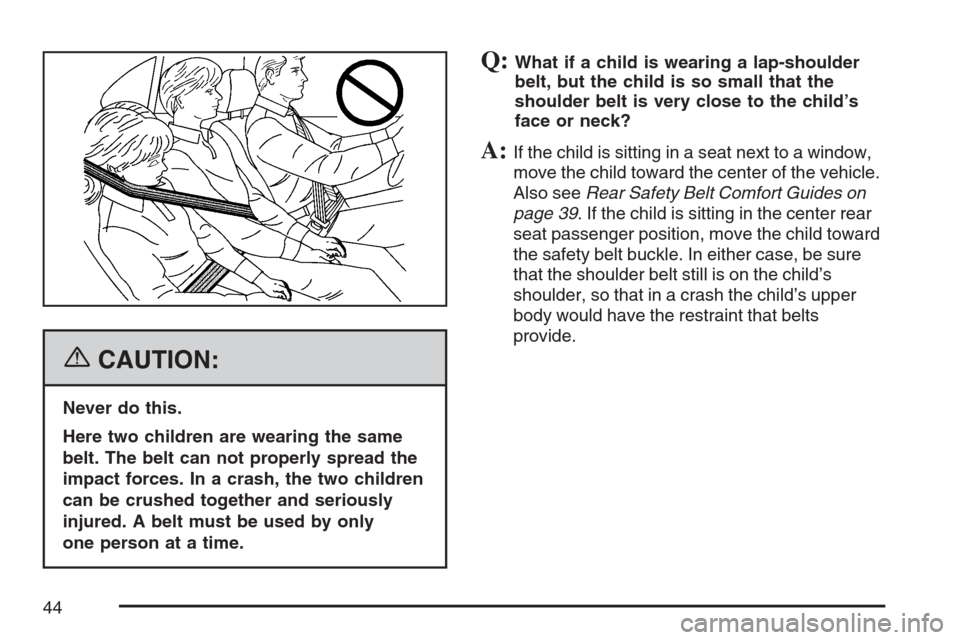
{CAUTION:
Never do this.
Here two children are wearing the same
belt. The belt can not properly spread the
impact forces. In a crash, the two children
can be crushed together and seriously
injured. A belt must be used by only
one person at a time.
Q:What if a child is wearing a lap-shoulder
belt, but the child is so small that the
shoulder belt is very close to the child’s
face or neck?
A:If the child is sitting in a seat next to a window,
move the child toward the center of the vehicle.
Also seeRear Safety Belt Comfort Guides on
page 39. If the child is sitting in the center rear
seat passenger position, move the child toward
the safety belt buckle. In either case, be sure
that the shoulder belt still is on the child’s
shoulder, so that in a crash the child’s upper
body would have the restraint that belts
provide.
44
Page 46 of 492
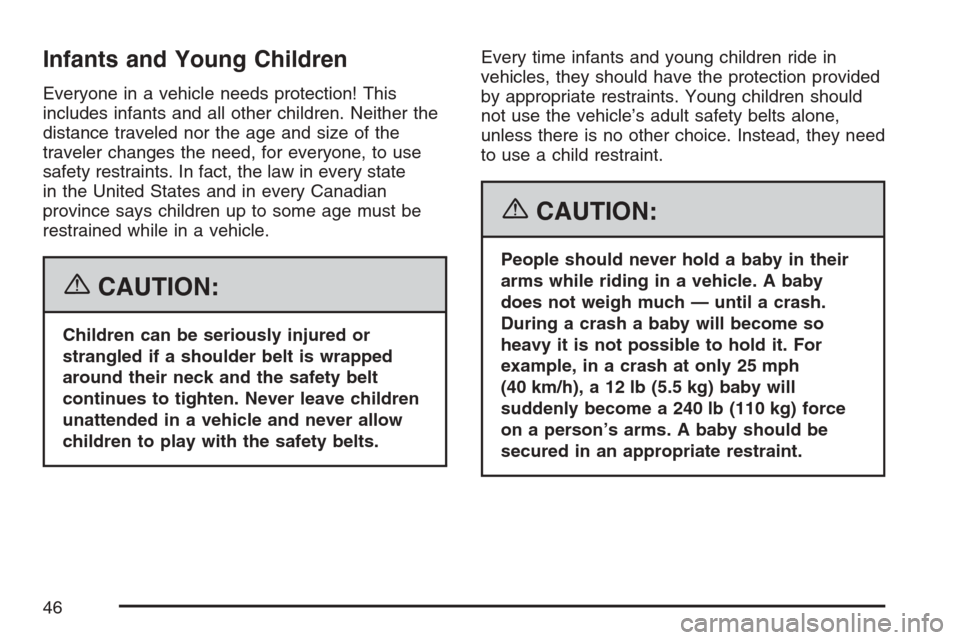
Infants and Young Children
Everyone in a vehicle needs protection! This
includes infants and all other children. Neither the
distance traveled nor the age and size of the
traveler changes the need, for everyone, to use
safety restraints. In fact, the law in every state
in the United States and in every Canadian
province says children up to some age must be
restrained while in a vehicle.
{CAUTION:
Children can be seriously injured or
strangled if a shoulder belt is wrapped
around their neck and the safety belt
continues to tighten. Never leave children
unattended in a vehicle and never allow
children to play with the safety belts.Every time infants and young children ride in
vehicles, they should have the protection provided
by appropriate restraints. Young children should
not use the vehicle’s adult safety belts alone,
unless there is no other choice. Instead, they need
to use a child restraint.
{CAUTION:
People should never hold a baby in their
arms while riding in a vehicle. A baby
does not weigh much — until a crash.
During a crash a baby will become so
heavy it is not possible to hold it. For
example, in a crash at only 25 mph
(40 km/h), a 12 lb (5.5 kg) baby will
suddenly become a 240 lb (110 kg) force
on a person’s arms. A baby should be
secured in an appropriate restraint.
46